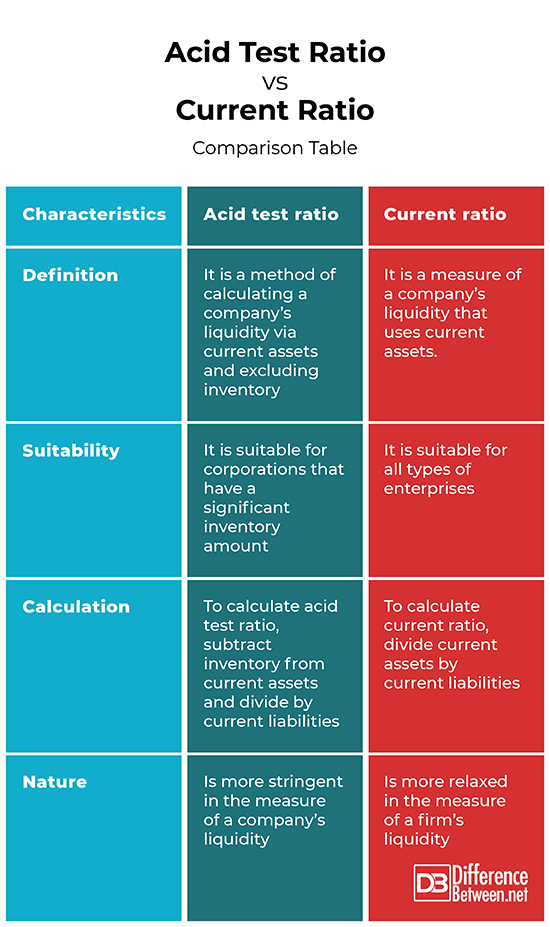Difference Between Acid Test Ratio and Current Ratio
Running any business is no walk in the park. While most enterprises prioritize assets as a measure of success, liquidity is equally important. What is liquidity, you might ask? This is how fast a company can convert assets into cash. However profitable an enterprise may be, non-liquidity is never a good sign. For instance, if things go awry and the business needs some help, liquidity is one of the first things that creditors will need to know, alongside other factors such as profitability.
Luckily, knowing a business’ liquidity level is not rocket science. Among methods that are used to measure liquidity include the acid test ratio and current ratio methods. Let’s discuss how these two ratios are derived and the differences between the two.

What is Acid Test Ratio?
Also referred to as quick ratio, the acid test ratio excludes inventory in the calculation of liquidity. This is because inventory is less liquid compared to other current assets, especially for businesses in the retail and manufacturing sectors. In most instances, such enterprises have significant inventory which is the most valuable current asset. This ratio only involves assets that are very liquid and can be converted to cash in 90 days or less.
It takes into account cash and cash equivalents, accounts receivable and marketable securities. Current liabilities used to calculate the acid test ratio include accounts payable, short-term debts and other debts as well as accrued liabilities.
To calculate the acid test ratio, subtract inventory from current assets and divide by current liabilities. The acid test ration provides a better liquidity position in comparison to the current ratio. While
Companies that have an acid test ratio of less than one are considered to be in a better financial position compared to those that have a ratio of less than one.

What is a Current Ratio?
Also referred to as the working capital ratio, the current ratio is a measure of a firm’s ability to pay short-term liabilities using current assets. On a company’s balance sheet, the ratio represents the value of assets that can be converted to cash in one year.
Some of the current assets used include accounts receivables, cash and cash equivalents, prepaid expenses, marketable securities and inventory. Current liabilities used include accounts payable, short-term debt and accrued liabilities.
To calculate the current ratio, current assets are divided by current liabilities. Similar to the acid test ratio, companies that have a current ratio of less than one have fewer current assets compared to the liabilities. This means that the company would be considered as a financial risk by creditors since the chances of paying its short-term obligations are harder. Companies that have a current ratio of more than one are considered more liquid and stand a better chance of getting credit if need be.
Similarities between Acid test ratio and Current ratio
- Both are used to determine the liquidity of
Differences between Acid test ratio and Current ratio
Definition
Acid test ratio is a method of calculating a company’s liquidity via current assets and excluding inventory. On the other hand, current ratio is a measure of a company’s liquidity that uses current assets.
Suitability
While acid test ratio is suitable for corporations that have a significant inventory amount, current ratio is suitable for all types of enterprises.
Calculation
To calculate acid test ratio, subtract inventory from current assets and divide by current liabilities. On the other hand, to calculate current ratio, divide current assets by current liabilities.
Nature
The acid test ratio is more stringent in the measure of a company’s liquidity. On the other hand, the current ratio is more relaxed in the measure of a firm’s liquidity.
Acid test ratio vs. Current Ratio: Comparison Table

Summary of Acid test ratio vs. Current ratio
Acid test ratio is a method of calculating a company’s liquidity via current assets and excluding inventory. It is calculated by subtracting inventory from current assets and dividing it by current liabilities. On the other hand, current ratio is a measure of a company’s liquidity that uses current assets. It is calculated by dividing current assets by current liabilities.
FAQs
Why is the acid test ratio always lower than the current ratio?
This is because an acid test ratio of 1:1 is always preferable while the ideal current ratio of 2:1 is preferable.
How do we interpret a current ratio and acid test ratio?
Anything more than 1 either in the current ratio or acid test ratio shows that the company is liquid enough to pay its debts.
What is a typical example of the difference between acid test ratio and current ratio?
For a company that has current assets valued at $100,000 and current liabilities of $50,000, the current ratio is 2 or 2:1. This is derived by dividing the total current assets by the total current liabilities. For a company that has quick assets valued at $40,000 and total current liabilities of $50,000, the acid test ratio is 0.8 or 0.8:1.
Which is better current ratio or quick ratio?
The quick ratio is better since its more stringent in determining a company’s liquidity.
- Difference Between Profit Center and Investment Center - July 2, 2022
- Difference Between Anti-Trust and Anti-Competition - June 6, 2022
- Difference Between Stocktaking and Stock Control - June 6, 2022
Search DifferenceBetween.net :
Leave a Response
References :
[0]Axel Tracy. Ratio Analysis Fundamentals: How 17 Financial Ratios Can Allow You to Analyse Any Business on the Planet. RatioAnalysis.net, 2012. https://books.google.co.ke/books?id=GadRYnALi-oC&printsec=frontcover&dq=Difference+between+acid+test+ratio+and+current+ratio&hl=en&sa=X&redir_esc=y#v=onepage&q=Difference%20between%20acid%20test%20ratio%20and%20current%20ratio&f=false
[1]Yannick Coulon. Rational Investing with Ratios: Implementing Ratios with Enterprise Value and Behavioral Finance. Springer Nature, 2019. https://books.google.co.ke/books?id=3X7HDwAAQBAJ&printsec=frontcover&dq=Difference+between+acid+test+ratio+and+current+ratio&hl=en&sa=X&ved=2ahUKEwjZw_-Z_Mb0AhXM8uAKHRz5BcEQ6AF6BAgIEAI#v=onepage&q=Difference%20between%20acid%20test%20ratio%20and%20current%20ratio&f=false
[2]Robert Leach. Ratios Made Simple: A beginner's guide to the key financial ratios. Harriman House Limited, 2010. https://books.google.co.ke/books?id=0ew3ajkyZc0C&printsec=frontcover&dq=Difference+between+acid+test+ratio+and+current+ratio&hl=en&sa=X&redir_esc=y#v=onepage&q=Difference%20between%20acid%20test%20ratio%20and%20current%20ratio&f=false
